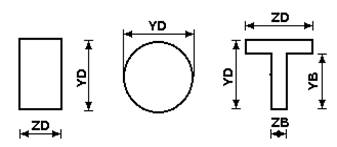D13.A.1 General
Russian Code SNiP 2.03.01–84* plain concrete and concrete structures is based on the method of limit states. Code SNiP 2.03.01–84* defines two groups of limit states.
Analysis according to the first group of limit states is performed to avoid the following phenomena:
-
brittle, plastic or other type of failure,
-
loss by structure of stable form or position,
-
fatigue failure,
-
failure due to the action of load actions and unfavorable environmental effects.
Analysis according to the second group of limit states is performed to avoid the following phenomena:
-
excessive and long-term opening of cracks if they are allowed according to service conditions,
-
excessive displacements.
Analysis of structures for the first group of limit states is performed with the use of the maximum (design) loads and actions. Analysis of structures for the second group of limit states is made in accordance with the operational (normative) loads and actions. Ratio between design and normative loads is called reliability coefficient for loads which is determined according to SNiP 2.01.07.-85 Loads and actions.
Reliability coefficient γn for destination according to SNiP 2.01.07.-85 shall be considered in determination of loads and their combinations.
Program STAAD.Pro makes it possible to calculate reinforcement for concrete members according to codes of many countries round the World and Russian Code SNiP 2.03.01-84* inclusive. Algorithms for calculation of reinforcement of concrete linear (beams, columns) and 2D (two dimensional) (slabs, walls, shells) members are incorporated in program STAAD.Pro. Not only Code SNiP 2.03.01-84* but also the Guide for design of plain concrete and reinforced concrete structures from normal weight and lightweight concrete (to SNiP 2.03.01-84) have been used in creation of these algorithms.
It is possible using program STAAD.Pro to calculate reinforcement for beams of rectangular or T section and for columns of rectangular or circular section (Fig.1).

Notation of dimensions for rectangular, circular and T sections
Flange of T-shape beams may be situated at the top zone of the section if the angle BETA=0°, or at the bottom zone of the section, if BETA=180°.
